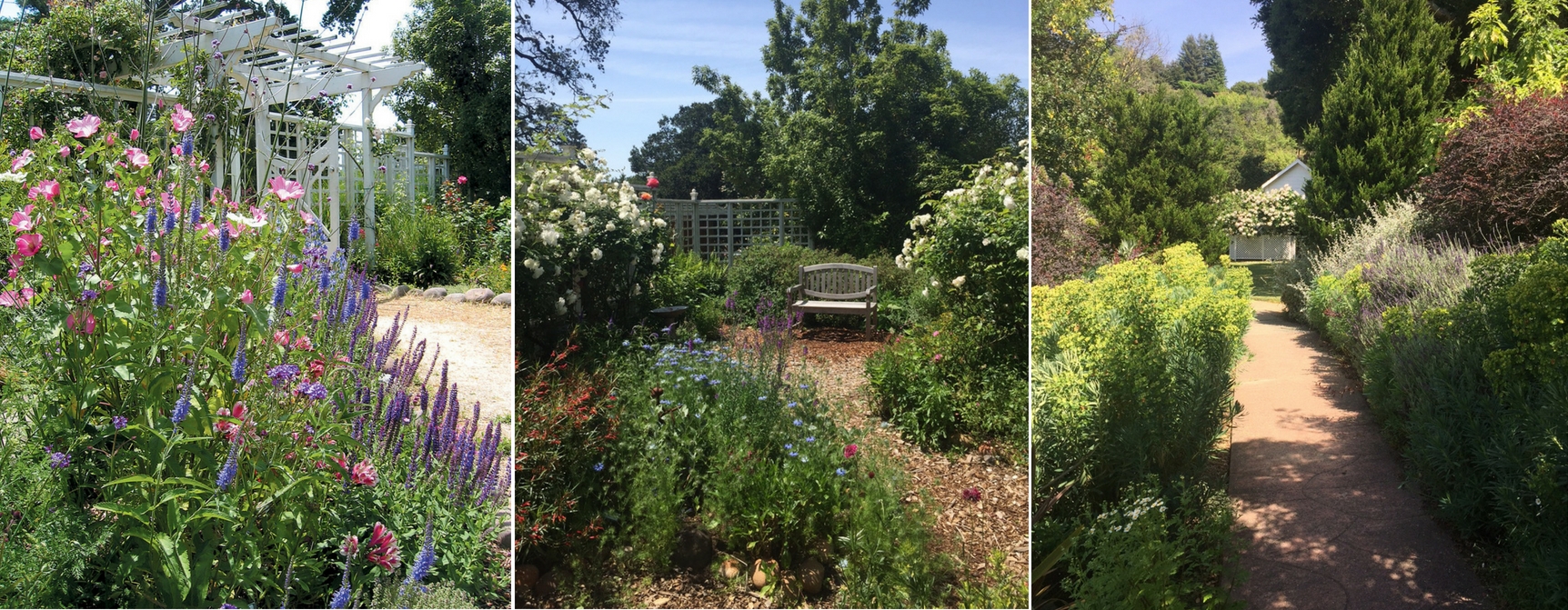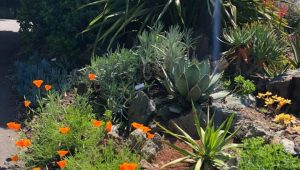Falkirk Demonstration Gardens

Stroll through our beautiful demonstration gardens
The University of California Marin Master Gardeners, in partnership with the City of San Rafael, created demonstration gardens, which include the Under Oaks Garden, Habitat Garden, Beneficial Garden, Lathe House Garden, Succulent Garden, Five Mediterranean Climate Zone Garden, and the most recently added Herb & Bee Garden.
Informative background and videos on each of the gardens. Provided by UC Marin Master Gardeners
Low Water Use/Drought Tolerant/Habitat Plants
Each garden provides something special for our mediterranean climate. The design of the Succulent Garden gives a nod to the Victorian era but also illustrates the range of these great plants for our present need for sustainability. Gorgeous, low-water use plants such as aloes, which provide food for birds and bees, are highlighted. The bees go crazy over them all winter, since they supply blooms when most plants are sleeping. Check out the Aloe Hercules for boldness! As well as the Aeoniums, Echeverias, agaves, and the sedem yin/yang design.
Like a small arboretum, the Mediterranean Climate Garden exhibits dozens of species from all the Mediterranean climate regions of the world: Australia, South Africa, Central Chile, Mediterranean Basin, and California/Baja.
In the Australian section, hummingbirds and bees are attracted to the Grevellias and the Kangaroo Paws.
In the South African section, check out the bee-attractors, Long-Leafed Waxflower and African Salvias, and watch the bees swarming over the Chilean Red Velvet Salvia and the herbs in the Mediterranean Basin.
The bee and hummingbird-loving native California plants include Toyon, Elderberry, Coffeeberry, ceanothus, Manzanita, and native mimulus and madia for use under California’s live oaks and provide food to flying creatures.
Permeable Paths and Reused Materials
The paths throughout the gardens are made of permeable decomposed granite and much of the materials used are locally sourced. The seating in the Under Oaks Amphitheatre, Mediterranean Garden, and Succulent Gardens are large re-used granite stones from the church that once stood next door.
Irrigation and Water Use
All of the gardens are on a Smart Controller system located inside the greenhouse. Master Gardener Tony Mekisich, in partnership with Marin Municipal Water District, helped install the irrigation system, which serves as a model for low-water use landscapes. The system uses drip lines and low-water pressure pop-ups.
To provide better water usage and to prevent erosion, the team dug five large swales as they installed the Mediterranean Garden . We also built berms in the Succulent Garden, as well as the Mediterranean Garden and placed plants at the top or bottom of the slope to provide organic water provision according to their needs. In order to insure the health of the oak trees, we did not place the plants under the trees on the water system. The Mediterranean Garden and Succulent Garden use less water each year as the plants become more established.
Mulches
A variety of mulches have been used in the gardens to demonstrate possibilities, including wood chips, stones, pebbles, lava and broken terracotta pots. Additionally, the natural oak leaf litter mulches the two areas under the live oaks.
Habitat Friendliness
All gardens are designed to foster wildlife. There is a bee box and a bee house in the habitat garden, and bird baths in three of the gardens provide water for birds, bees and butterflies, bird houses in three of the gardens (at least two inhabited) provide homes and shelter, and tree stumps and hollows offer habitat spaces for various creatures. Plantings throughout the garden provide food for bees, butterflies, and birds.
Trees for Shade
In the Succulent Rock Garden closest to the house, we planted three Catalpa trees to provide some shade for this fabulous collection of succulents. In the Mediterranean Garden, an oak tree provides shade while a number of three-year old trees such as Mayten, Arbutus, the wonderful Blue Bush Wattle, River Wattle, and Ceanothus continue growing toward a shadier future. The Under Oak Garden is shaded, appropriately enough, by a large oak tree.
Deer Resistant Plants
All of the plants in the Mediterranean and Succulent Gardens are home to families of deer, so these plants have proven to be unattractive to this group of deer.
Fire Resistant Plants
Most of the plants in the Mediterranean Garden and all of the Succulents are resistant to fire and are placed close to the mansion.


